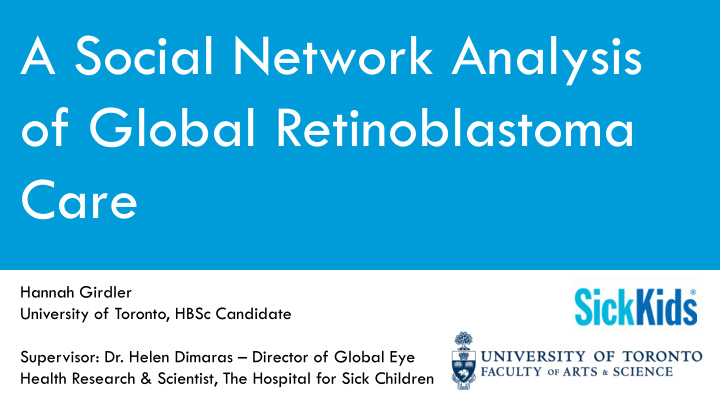



A Social Network Analysis of Global Retinoblastoma Care Hannah Girdler University of Toronto, HBSc Candidate Supervisor: Dr. Helen Dimaras – Director of Global Eye Health Research & Scientist, The Hospital for Sick Children
OUTLINE Introduction Results Significance Methodology
INTRODUCTION What is Retinoblastoma? • Rare infant eye cancer of the retina • Globally, approximately 8000 new cases a year • 20% survival rate in developing world, 95% in developed Hypothesis: A social network analysis of the One Retinoblastoma World map will identify the prevalence and types of connections, uncover key actors and reveal powerful ways to amplify existing collaborative efforts to reduce inequities and improve survival
METHODOLOGY: AN EGOCENTRIC SOCIAL NETWORK ANALYSIS Social Network Analysis: Network maps that measure individual relationships, capturing the overall connectedness of all partners within a social network One Retinoblastoma World network (1rbw.org) Mixed method Quantitative survey and qualitative semi-structured interviews
METHODOLOGY: AN EGOCENTRIC SOCIAL NETWORK ANALYSIS Conduct In- Development Depth Interviews of Survey 1 2 3 4 Conduct Data Surveys Analysis
METHODOLOGY: QUANTITATIVE SURVEY TYPES OF PARTNERSHIPS/ COLLABORATIONS
RESULTS: QUANTITATIVE SURVEY
RESULTS: QUANTITATIVE SURVEY International and National Collaborations • Ex: South Asia • Mostly national collaborations • Ex: Sub-Saharan Africa • Mix of national and international collaborations • Ex: Europe and Central Asia • Mostly international collaborations
Patient Referrals Sent Joint Planning Other Collaborations Patient Consultations Initiated RESULTS: QUANTITATIVE SURVEY EXAMPLES OF PRELIMINARY SOCIAL NETWORK MAPS
NEXT STEPS: Finish conducting qualitative interviews • Ensure that key informants who participate represent a wide demographic of retinoblastoma centers • 22 retinoblastoma treatment centers selected as key informants • Questions build off of survey results • Focus more on the value of partnerships generally • e.g. strengths, weaknesses, value added and history Data analysis • Perform thematic analysis on data from surveys, social network maps and semi- structured interviews • Determine if there are ways to amplify successful collaboration
SIGNIFICANCE: Goals of the social network analysis of the One Retinoblastoma World network: • Identify the prevalence and types of collaborations that are present • Uncover key actors • Amplify existing collaborative efforts Why is this important? • First study to analyze the partnerships within this network • Can identify the ways to foster successful partnerships and improve patient outcomes
THANK YOU! On behalf all authors and other contributors involved in this project: Hannah Girdler, Dr. Helen Dimaras, Kaitlyn Hougham, Iva Avramov, Catherine Moses, John Prochaska and Amanda Otter. Funding: Hannah Girdler is funded by the Queen Elizabeth II Diamond Jubilee Scholarship on a separate research study that is supporting her time in Nairobi, Kenya this summer.
Recommend
More recommend